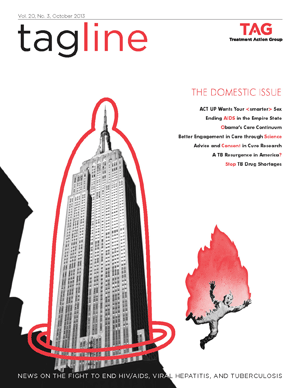
By Mark Harrington
In death one can’t be vocal or witness time and motion and physical events with breath, one can’t make change. Abstract ideas of energy dispersing, some ethical ocean crawls through a funnel of stars, outlines of the body, energy in the shape of a body, a vehicle then extending losing boundaries separating expanding into everything. Into nothingness. It’s just I can’t paint. I can’t loosen this gesture if I’m dead.
—David Wojnarowicz, In the Shadow of the American Dream
The past decade has brought astonishing developments in HIV disease management: antiretroviral therapy options that are safer, more effective, and easier to take than their predecessors; evidence that HIV treatment can substantially reduce the risk of transmitting the virus; rapid assays to detect HIV within days of infection; and the approval of preexposure prophylaxis (PrEP) to minimize the risk of infection among those at risk. Yet the U.S. epidemic continues unabated. Roughly 50,000 U.S. residents are newly infected every year (with a recent 22 percent increase among young gay and bisexual men). Of all U.S. residents living with HIV, one in five is unaware of having been infected; only one in four has an undetectable viral load; and less than half are in continuous care.
We are at a stalemate. This issue of TAGline underscores TAG’s commitment to ending AIDS in the United States and realizing the goals of the National HIV/AIDS Strategy.
Scott Morgan discusses how the president’s recently announced HIV Care Continuum Initiative represents a victory for advocates, while Tim Horn writes about the need for an implementation science agenda designed to improve engagement in care. Coco Jervis describes encouraging progress—spurred by activists—to develop a comprehensive plan to end AIDS in New York State. And Jim Eigo and James Krellenstein of ACT UP/NY review the tremendous advocacy work under way to force New York City’s health department to ramp up HIV prevention and testing efforts.
Also in this issue is Richard Jefferys’s clear-eyed synopsis of the ethical considerations surrounding essential cure-related research.
Advocacy for sound domestic health care policy must also extend to tuberculosis (TB). As Jervis and Lindsay McKenna explain in separate articles, political apathy, dwindling federal and state resources, and an uptick in domestic drug shortages have already caused public health crises, and, without bold strategies quickly put into place, may lead to a resurgence of this deadly and costly disease.
There are challenges ahead, including this country’s hepatitis C epidemic. Upcoming issues of TAGline will cover the advancement of direct-acting antivirals, which are bringing us closer to the day when hepatitis C can be cured with all-oral, interferon-free treatment regimens.
Fortunately, the opportunities to end the HIV, TB, and hepatitis C epidemics in the United States have never been greater. •
